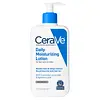CeraVe Daily Moisturizing Lotion Normal To Dry Skin Versus Trader Joe's Oil-Free Antioxidant Facial Moisturizer
What's inside
What's inside
 Key Ingredients
Key Ingredients

 Benefits
Benefits

 Concerns
Concerns

 Ingredients Side-by-side
Ingredients Side-by-side

Water
Skin ConditioningGlycerin
HumectantCaprylic/Capric Triglyceride
MaskingCetearyl Alcohol
EmollientCetyl Alcohol
EmollientPotassium Phosphate
BufferingCeramide NP
Skin ConditioningCeramide AP
Skin ConditioningCeramide EOP
Skin ConditioningCarbomer
Emulsion StabilisingDimethicone
EmollientCeteareth-20
CleansingBehentrimonium Methosulfate
Methylparaben
PreservativeSodium Lauroyl Lactylate
EmulsifyingCholesterol
EmollientDisodium EDTA
Dipotassium Phosphate
BufferingPropylparaben
PreservativeHydrolyzed Hyaluronic Acid
HumectantPhytosphingosine
Skin ConditioningXanthan Gum
EmulsifyingPolysorbate 20
EmulsifyingPolyglyceryl-3 Diisostearate
EmulsifyingWater, Glycerin, Caprylic/Capric Triglyceride, Cetearyl Alcohol, Cetyl Alcohol, Potassium Phosphate, Ceramide NP, Ceramide AP, Ceramide EOP, Carbomer, Dimethicone, Ceteareth-20, Behentrimonium Methosulfate, Methylparaben, Sodium Lauroyl Lactylate, Cholesterol, Disodium EDTA, Dipotassium Phosphate, Propylparaben, Hydrolyzed Hyaluronic Acid, Phytosphingosine, Xanthan Gum, Polysorbate 20, Polyglyceryl-3 Diisostearate
Water
Skin ConditioningAloe Barbadensis Leaf Juice
Skin ConditioningEthylhexyl Palmitate
EmollientGlycerin
HumectantGlyceryl Stearate
EmollientPolysorbate 60
EmulsifyingCetearyl Alcohol
EmollientPhenoxyethanol
PreservativeCetearyl Glucoside
EmulsifyingSodium PCA
HumectantEthylhexylglycerin
Skin ConditioningPersea Gratissima Fruit Butter
EmollientTocopheryl Acetate
AntioxidantXanthan Gum
EmulsifyingTocopherol
AntioxidantSorbic Acid
PreservativeSoluble Collagen
HumectantPanthenol
Skin ConditioningAscorbyl Palmitate
AntioxidantPunica Granatum Extract
AstringentGinkgo Biloba Leaf Extract
Skin ConditioningCoffea Arabica Seed Oil
MaskingChamomilla Recutita Flower
Skin ConditioningCamellia Sinensis Leaf Extract
AntimicrobialSodium Hyaluronate
HumectantSorbitan Stearate
EmulsifyingPhytonadione Epoxide
AstringentMenadione
MaskingHydrolyzed Silk
Humectant2-Dimethylamino Ethanol
Copper PCA
HumectantRetinol
Skin ConditioningRetinyl Palmitate
Skin ConditioningUbiquinone
AntioxidantThioctic Acid
AntioxidantCholecalciferol
Polysorbate 20
EmulsifyingC12-15 Alkyl Benzoate
AntimicrobialPhospholipids
Skin ConditioningWater, Aloe Barbadensis Leaf Juice, Ethylhexyl Palmitate, Glycerin, Glyceryl Stearate, Polysorbate 60, Cetearyl Alcohol, Phenoxyethanol, Cetearyl Glucoside, Sodium PCA, Ethylhexylglycerin, Persea Gratissima Fruit Butter, Tocopheryl Acetate, Xanthan Gum, Tocopherol, Sorbic Acid, Soluble Collagen, Panthenol, Ascorbyl Palmitate, Punica Granatum Extract, Ginkgo Biloba Leaf Extract, Coffea Arabica Seed Oil, Chamomilla Recutita Flower, Camellia Sinensis Leaf Extract, Sodium Hyaluronate, Sorbitan Stearate, Phytonadione Epoxide, Menadione, Hydrolyzed Silk, 2-Dimethylamino Ethanol, Copper PCA, Retinol, Retinyl Palmitate, Ubiquinone, Thioctic Acid, Cholecalciferol, Polysorbate 20, C12-15 Alkyl Benzoate, Phospholipids
 Reviews
Reviews

Ingredients Explained
These ingredients are found in both products.
Ingredients higher up in an ingredient list are typically present in a larger amount.
Cetearyl alcohol is a mixture of two fatty alcohols: cetyl alcohol and stearyl alcohol. It is mainly used as an emulsifier. Emulsifiers help prevent the separation of oils and products. Due to its composition, it can also be used to thicken a product or help create foam.
Cetearyl alcohol is an emollient. Emollients help soothe and hydrate the skin by trapping moisture.
Studies show Cetearyl alcohol is non-toxic and non-irritating. The FDA allows products labeled "alcohol-free" to have fatty alcohols.
This ingredient is usually derived from plant oils such as palm, vegetable, or coconut oils. There is debate on whether this ingredient will cause acne.
Due to the fatty acid base, this ingredient may not be Malassezia folliculitis safe.
Learn more about Cetearyl AlcoholGlycerin is already naturally found in your skin. It helps moisturize and protect your skin.
A study from 2016 found glycerin to be more effective as a humectant than AHAs and hyaluronic acid.
As a humectant, it helps the skin stay hydrated by pulling moisture to your skin. The low molecular weight of glycerin allows it to pull moisture into the deeper layers of your skin.
Hydrated skin improves your skin barrier; Your skin barrier helps protect against irritants and bacteria.
Glycerin has also been found to have antimicrobial and antiviral properties. Due to these properties, glycerin is often used in wound and burn treatments.
In cosmetics, glycerin is usually derived from plants such as soybean or palm. However, it can also be sourced from animals, such as tallow or animal fat.
This ingredient is organic, colorless, odorless, and non-toxic.
Glycerin is the name for this ingredient in American English. British English uses Glycerol/Glycerine.
Learn more about GlycerinPolysorbate 20 is made by combining ethoxylation of sorbitan, ethylene oxide, and lauric acid. It is a mild cleansing agent, surfactant, and emulsifier.
As a surfactant, it helps collect dirt and oils for washing. Emulsifiers prevent oils and water from separating.
Polysorbate 20 also adds scent to a product. Since it is made using sorbitol, it has a sweet scent. Sorbitol can also be found in fruits such as apples and peaches.
The lauric acid used to create Polysorbate 20 is often derived from coconuts.
Polysorbate 20 may not be fungal acne safe.
Learn more about Polysorbate 20Water. It's the most common cosmetic ingredient of all. You'll usually see it at the top of ingredient lists, meaning that it makes up the largest part of the product.
So why is it so popular? Water most often acts as a solvent - this means that it helps dissolve other ingredients into the formulation.
You'll also recognize water as that liquid we all need to stay alive. If you see this, drink a glass of water. Stay hydrated!
Learn more about WaterXanthan gum is used as a stabilizer and thickener within cosmetic products. It helps give products a sticky, thick feeling - preventing them from being too runny.
On the technical side of things, xanthan gum is a polysaccharide - a combination consisting of multiple sugar molecules bonded together.
Xanthan gum is a pretty common and great ingredient. It is a natural, non-toxic, non-irritating ingredient that is also commonly used in food products.
Learn more about Xanthan Gum